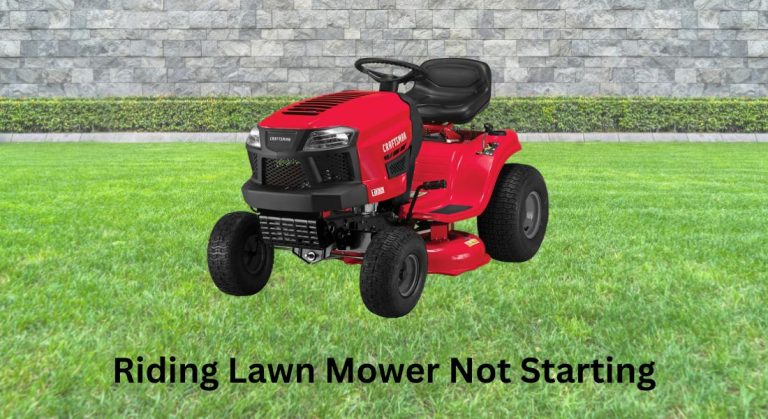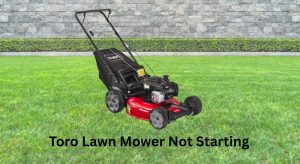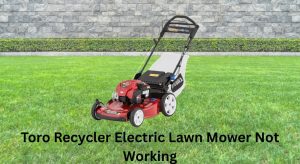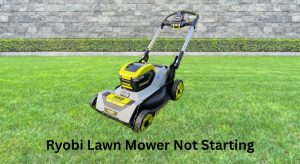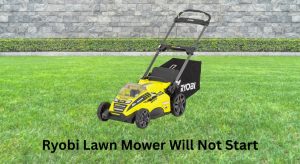When your riding lawn mower won’t start, it’s frustrating—especially with grass growing fast and your weekend ticking away. The good news? Most “riding lawn mower not starting” issues come down to a few common problems you can fix quickly. The fastest quick fix: check the safety switches (seat, brake, blade/ PTO), ensure the battery terminals are tight and clean, and spray a small shot of carb cleaner into the air intake—if it fires briefly, you’ve isolated a fuel delivery problem.
In this comprehensive troubleshooting guide, you’ll learn every likely cause and how to fix each one—from dead batteries and bad spark plugs to clogged carburetors and faulty solenoids. You’ll also get prevention tips to keep your mower starting reliably all season. By the end, you’ll know exactly how to diagnose and repair a riding mower that won’t start, crank, or stay running.
Common Causes of a Riding Lawn Mower Not Starting
- Dead or weak battery (under 12.4V resting voltage)
- Corroded or loose battery terminals, ground strap, or cables
- Faulty ignition switch or blown fuse
- Bad starter solenoid or starter motor
- Safety interlock switch failure (seat, brake, PTO/blade)
- Stale fuel or empty tank (yes, it happens)
- Clogged fuel filter or fuel line
- Bad fuel shutoff valve or vented gas cap blocked
- Dirty carburetor or stuck float/needle
- Bad spark plug or coil (ignition module)
- Air filter clogged or choke not working
- Faulty PTO switch (blades engaged while starting)
- Low oil level triggering shutoff on some models
- Flooded engine
How to Fix a Riding Lawn Mower That Won’t Start

Below are multiple methods ordered from fastest/easiest to more advanced. Use the “Diagnosing” subsections to confirm the issue before replacing parts.
Method 1: Quick Checks and Easy Wins
Diagnosing the Issue
- Does it crank? If yes but won’t fire, likely fuel/ignition issue.
- No crank at all? Likely battery, solenoid, safety switch, or ignition.
- Click only? Weak battery or bad solenoid/starter.
- Starts, then dies? Fuel delivery/venting or safety switch.
Fix Steps
- Verify safety positions:
– Set parking brake fully.
– Disengage blades/PTO.
– Sit firmly on the seat (or ensure seat switch is pressed). - Check fuel:
– Confirm fresh, ethanol-free or E10 max gasoline under 30 days old.
– Open the gas cap—listen for a vacuum hiss. If the mower starts with cap loosened, the cap vent is clogged. - Inspect battery connections:
– Tighten both terminals with a wrench. Clean corrosion with a baking soda paste and wire brush.
– Ensure the ground cable to frame/engine is tight and rust-free. - Choke and throttle:
– Cold start: choke ON; warm start: choke OFF, half throttle. - Try a quick-start test:
– Remove air filter, spray a 1-second burst of carb/choke cleaner into intake, reinstall filter cover, and start. If it fires briefly, the issue is fuel delivery.
Testing
- Attempt to start. If still no crank, move to Method 2. If cranks but no fire, go to Method 3 or 4.
Method 2: Battery, Cables, and Starter Circuit
Diagnosing the Issue
- Measure battery: Resting voltage should be 12.6–12.8V (fully charged). 12.4V is ~75%, 12.2V ~50%, below 12.0V is discharged.
- Load test: Voltage while cranking should remain above ~10.5V. If it drops lower, the battery is weak.
- Listen for clicks: One click = solenoid trying; rapid clicks = low voltage; no click = switch/fuse/safety circuit.
Fix Steps
- Charge the battery:
– Use a smart 12V charger at 2–10A until full (typically 4–8 hours). - Inspect fuses and ignition switch:
– Locate inline fuse (often 15–20A near battery). Replace if blown. Use the same rating only.
– Wiggle ignition key while starting; intermittent action suggests a failing switch. - Check cables:
– Replace frayed or heat-damaged cables. Ensure ring terminals are tight at solenoid and starter. - Test solenoid:
– With key in START, check for 12V on the small trigger terminal. If present but no click, solenoid is likely bad.
– Bypass test (advanced): Briefly bridge the solenoid’s two large posts with an insulated screwdriver. If the starter spins, solenoid is bad. If not, suspect starter or battery.
– Important: Wear gloves/eye protection. Expect sparks. Do not touch chassis. - Starter motor:
– If solenoid clicks and sends power but starter doesn’t spin, bench test starter or replace.
Testing
- After charging/repairs, attempt to start. If cranks strongly now, proceed. If still dead, inspect safety switches (Method 5).
Method 3: Fuel System and Carburetor
If the engine cranks but won’t fire, and quick-start spray briefly runs the engine, you likely have a fuel problem.
Diagnosing the Issue
- Old fuel smells varnishy and looks darker.
- Fuel filter half-full or opaque with debris.
- No fuel flow when line disconnected from carb.
- Bowl solenoid click? Some carbs have an anti-backfire solenoid—listen for a click when turning key ON.
Fix Steps
- Replace stale fuel:
– Drain the tank with a siphon or remove fuel line and drain into a safe container.
– Refill with fresh gas; add fuel stabilizer if desired. - Check the fuel filter:
– Replace inline filter (arrow points toward carb). Cheap and worth doing annually. - Inspect fuel line and shutoff valve:
– Ensure valve is ON and not clogged. Replace brittle hoses. Use 1/4″ or 5/16″ fuel line as applicable, ethanol-resistant. - Gas cap vent:
– Try starting with cap loosened. If it starts, replace cap. - Carburetor clean:
– Remove the carb bowl (10mm/1/2″ typically). Clean out varnish and debris.
– Remove and clean main jet with carb cleaner and a soft bristle (do not enlarge orifices).
– Verify float moves freely; needle valve not stuck.
– Replace bowl gasket/O-ring if swollen.
– For Nikki, Walbro, or Keihin carbs commonly on Briggs & Stratton, Kohler, Kawasaki engines, consider a full rebuild kit if heavily gummed. - Anti-backfire solenoid:
– With key ON, confirm the plunger retracts. If not, check for 12V at connector. Replace solenoid if failed.
Testing
- Prime by cranking 5–8 seconds with choke. If firing improves, fuel is restored. If still no start, check spark (Method 4).
Method 4: Spark, Ignition, and Air
Diagnosing the Issue
- Remove spark plug, connect to wire, ground the plug to the engine, and crank. Look for a strong blue spark.
- Wet plug tip indicates flooding; bone-dry suggests fuel starvation.
- Black, sooty plug = rich; white blistered = lean/overheat.
Fix Steps
- Replace spark plug:
– Common types: Briggs & Stratton (J19LM, RJ19LM), Kohler (Kohler cross-reference), Kawasaki (BPR4ES). Gap typically 0.028–0.030″—verify your engine manual.
– Use a new plug and torque snugly (do not overtighten). - Check ignition coil/module:
– Inspect the kill wire from coil to harness—if chafed/grounded, no spark.
– Set coil air gap to manufacturer spec (often 0.010–0.014″) using a business card shim on the flywheel magnet.
– If no spark with kill wire disconnected, replace the coil. - Air filter and choke:
– Replace a clogged air filter; ensure choke plate fully closes when engaged. - Un-flood the engine:
– Remove plug, crank for 10 seconds to clear cylinder, let sit 15 minutes, reinstall dry plug, start with choke OFF and throttle 1/2.
Testing
- With fresh plug and functional coil, you should see robust spark and a quick start. If spark is good but still no start, re-verify fuel delivery and compression.
Method 5: Safety Interlocks and PTO Switch
Modern riding mowers have safety switches that prevent starting.
Diagnosing the Issue
- Symptoms: No crank at all despite a good battery; cranks then dies when you release brake; dies when engaging blades.
- Common switches: Seat switch, brake/clutch switch, PTO/blade engagement switch, neutral switch.
Fix Steps
- Seat switch:
– Ensure seat is not torn or misaligned. Press down while cranking.
– Inspect connector under seat for corrosion or loose pins. - Brake/clutch switch:
– Fully depress pedal. Adjust linkage if pedal doesn’t press the switch fully. - PTO/blade switch:
– Verify knob is disengaged (OFF). Test the switch continuity; replace if faulty. - Wiring and connectors:
– Look for rubbed-through wires, especially near hinge points and under the seat.
Testing
- Try to start after each switch check. If it cranks with switch bypassed for test but not otherwise, replace the faulty switch. Important: Do not operate with safety switches permanently bypassed.
Method 6: Engine-Specific Issues (Compression, Timing, Mechanical)
If you have spark, fuel, and air but still no start, consider mechanical faults.
Diagnosing the Issue
- Low compression (<60–90 psi) can prevent starting.
- Backfiring through carb may indicate valve/timing issues or a sheared flywheel key (after hitting an object).
- Excessive crankcase oil level can hydro-lock the engine (especially on V-twins).
Fix Steps
- Check oil level:
– Correct overfill. If oil smells like gas, the carb needle may be leaking—rebuild carb and change oil. - Flywheel key:
– If the mower stopped abruptly after hitting something and now won’t start or backfires, inspect and replace the flywheel key. - Valves and lash:
– On OHV engines, set valve clearance to spec (e.g., Briggs Intek: intake ~0.004–0.006″, exhaust ~0.006–0.008″). Incorrect lash can cause hard starting. - Head gasket:
– Blow-by or hissing could indicate a blown gasket—common on some Briggs single-cylinder engines. Replace gasket if compression is low.
Testing
- After mechanical corrections, retest starting. If still failing, professional diagnostics may be warranted.
How to Prevent Future Starting Issues
- Use fresh, top-tier gasoline; avoid storing fuel longer than 30 days. Add stabilizer if needed.
- Install a quality inline fuel filter and replace annually.
- Keep battery on a smart maintainer during off-season.
- Clean and tighten battery and ground connections twice per season.
- Change oil and air filter per manual; replace spark plug annually.
- Run the engine dry or shut fuel valve when storing to prevent carb varnish.
- Mow off the wet grass; moisture can corrode connectors and foul filters.
- Periodically test safety switches for reliable operation.
Pro Tips
- Label your safety switch connectors during inspection to avoid mix-ups.
- Keep a can of carb cleaner and a spare spark plug in the garage—these two items diagnose most no-start cases quickly.
- When chasing no-crank problems, start at the battery and follow power forward: battery → fuse → key switch → safety switches → solenoid → starter.
- Use dielectric grease on connectors under the seat and near the frame to reduce corrosion.
- For ethanol-related issues, consider ethanol-free fuel (E0) or at least E10 with stabilizer.
- If the engine cranks slowly even with a good battery, check for a partially seized starter or tight valve lash causing compression release failure.
- Don’t over-choke a warm engine—this floods quickly and fouls plugs.
When to Call a Professional
- You have verified good battery, spark, fuel, and air, but the engine still won’t start.
- Electrical diagnosis is beyond your tools/comfort (e.g., tracing shorts, module testing).
- Suspected internal engine issues: low compression, broken rings, bent pushrods, or blown head gasket.
- Carburetor rebuilds on multi-cylinder/Kawasaki/Kohler with anti-tamper jets if you lack ultrasonic cleaner and kits.
- Frequent fuse blowing or melted connectors (possible short circuit).
- Hydro-lock from fuel-in-oil repeatedly—can indicate deeper carb/needle or fuel pump problems.
What to look for in a service provider:
– Certified for your engine brand (Briggs & Stratton, Kohler, Kawasaki).
– Clear diagnostic fee and turnaround time.
– Warranty on parts/labor (typically 30–90 days).
– Typical costs (varies by region):
– Battery replacement: $60–$150
– Carburetor clean/rebuild: $90–$250
– Starter/solenoid replacement: $80–$250
– Full diagnostic: $50–$120
Warranty considerations:
– If under manufacturer or dealer warranty, avoid DIY wiring modifications—may void coverage.
– Keep receipts for parts and maintain records.
FAQ
Q: My riding lawn mower clicks but won’t start. What’s wrong?
A: A single loud click usually points to a weak battery or a bad starter solenoid. Check battery voltage (should be 12.6V+), clean/tighten terminals, and test the solenoid. If bypassing the solenoid spins the starter, replace the solenoid.
Q: The engine cranks but won’t fire. How do I diagnose fuel vs. spark?
A: Spray a 1-second burst of carb cleaner into the intake. If it fires briefly, it’s a fuel issue (filter, pump, lines, carb). If it makes no difference, check for strong spark, plug condition, and ignition coil.
Q: Should I use a fuel stabilizer?
A: Yes. If fuel will sit more than 30 days, add stabilizer at purchase. It slows oxidation, reduces varnish, and helps prevent carburetor clogs.
Q: Why does my mower start only with the gas cap loosened?
A: The vent in the gas cap is likely clogged, causing vacuum lock. Replace the cap so the tank can vent properly.
Q: How often should I replace the spark plug and air filter?
A: Replace the spark plug annually or every 100 hours, and the air filter every season or more often in dusty conditions. Clean foam pre-filters every 25 hours.
Q: What causes backfiring through the carb when starting?
A: Common causes are a sheared flywheel key (timing off), incorrect valve lash, or lean mixture from a clogged jet. Inspect the flywheel key and set valve clearances to spec.
Q: My mower dies when I release the brake pedal. Why?
A: The brake/clutch safety switch may be misadjusted or faulty. Verify the pedal fully engages the switch and check the wiring connector.
Q: Can I jump-start my mower with a car?
A: Yes, but with safety: car engine OFF, connect positive-to-positive, negative to mower frame ground, start the mower, then remove cables. Prolonged high amperage from a running car alternator can damage the mower’s electrics.
Alternative Solutions
Sometimes repeated carb issues or persistent electrical failures make repair less economical.
| Solution | Pros | Cons | Best For |
|---|---|---|---|
| Replace carburetor with new OEM/Aftermarket | Fast fix, restores performance | Cost $40–$150; must match model | Heavily varnished carbs |
| Convert to shutoff valve/use ethanol-free fuel | Prevents flooding, cleaner fuel system | Requires installing valve if not present | Seasonal storage |
| Lithium battery upgrade (LiFePO4 mower-sized) | Higher cranking power, lighter, long life | Higher upfront cost, needs compatible charger | Frequent cold starts |
| Professional annual service | Reliability, full inspection | Service cost and scheduling | Busy owners, large properties |
Get Your Riding Lawn Mower Working Again
By following this guide, you now have multiple ways to fix a riding lawn mower not starting:
– Quick safety, fuel, and battery checks
– Battery, solenoid, and starter diagnostics
– Fuel system cleaning and carburetor fixes
– Spark, ignition coil, and air filter repairs
– Safety switch and mechanical timing/valve checks
Don’t let a no-start ruin your mowing schedule. Work through these methods in order—most riders are back up and running after a battery service, fresh fuel, and a carb clean. If you’re still stuck, a professional can quickly pinpoint deeper electrical or mechanical issues.
Have you solved your riding lawn mower not starting? Share what fixed it in the comments to help other readers. Found this helpful? Bookmark it for your next tune-up. You’ve got this!

